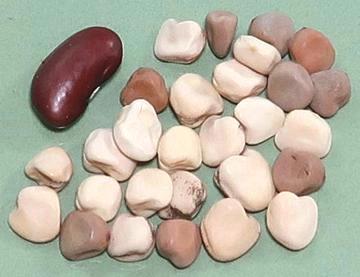 [Khesari (India); Guaya (Ethiopia); Blue sweet pea, Chickling vetch,
Indian pea, Indian vetch, White vetch; Almorta / Alverjon (Spain);
Cicerchia (Italy); Tsulispira (Georgia); Lathyrus sativus]
[Khesari (India); Guaya (Ethiopia); Blue sweet pea, Chickling vetch,
Indian pea, Indian vetch, White vetch; Almorta / Alverjon (Spain);
Cicerchia (Italy); Tsulispira (Georgia); Lathyrus sativus]
Grass Pea grows well under drought conditions and is sometimes the only food available in parts of Ethiopia, Pakistan, India and Nepal, and in times past in southern Europe. It is nutritious and high in protein, but contains a neurotoxin that causes paralysis, particularly of the legs. People in affected areas can either die now of starvation or risk living the rest of their lives as cripples, not a comfortable choice.
The neurotoxin is not highly dangerous unless grass pea is a major part of the diet for a period of time (30% to 40% for 2 to 6 months). That is fortunate because in India and Nepal grass pea is often used as a cheap adulterant in pigeon peas (Toor / Tuvar) or Bengal chick peas (Chana). This is often as a dal (peeled and split) which is more difficult to detect than with whole grass peas, or as flour (besan) which is just about impossible to detect. It is certain grass pea will continue to be used as human food, because nothing else grows satisfactorily under the same conditions. Scientists in India are working to breed varieties low in neurotoxins.
Grass Pea is a significant crop in the mountainous regions of R. Georgia, especially at altitudes where beans do not grow well. It is often used in soups, but I have a Georgian cookbook that also has recipes for the stems, stripped of leaves and boiled for use as a vegetable.
Grass pea has currently (2019) become very popular in Italy, and this popularity is spreading to North America under the Italian name "Cicerchia". It is still little known except to Chefs in fancy Italian restaurants. Already grown in some private gardens, I suspect it will soon be grown commercially in California. It is also grown in the La Mancha region of Spain. It is not dangerous in these regions because it is a minor item in the diet.
More on Beans, Peas and Lentils
Buying: Currently (2019), this pea is available on-line, imported from Italy. The photo specimes were purchased for 2019 US $10 / pound.
Cooking: These peas are soaked overnight with some salt, just as other dried beans. Some cooks say to par boil the soaked peas and discard the water three times before cooking for the recipe. I have doubts this par boiling has any actual effect, other than making the cook feel more comfortable about serving a toxic pea.
bp_oforz 191019 - www.clovegarden.com